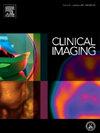Causal Inference Using Multimodal Propensity Score Adjustment for Assessing Gelatin Sponge Efficacy in Preventing Lung Biopsy Related Hemorrhage
IF 1.5
4区 医学
Q3 RADIOLOGY, NUCLEAR MEDICINE & MEDICAL IMAGING
引用次数: 0
Abstract
Purpose
Pulmonary hemorrhage is a potentially serious complication of CT-guided percutaneous lung biopsy. While gelatin sponge embolization of the needle tract is widely used for pneumothorax prevention, its effectiveness against hemorrhage remains uncertain. We aimed to assess whether prophylactic gelatin sponge tract embolization reduces the incidence of radiologically significant pulmonary hemorrhage, using advanced propensity score–based techniques.
Materials and methods
We retrospectively analyzed 1812 patients who underwent CT-guided lung biopsy between 2018 and 2022. Clinically significant hemorrhage was defined as grade ≥ 2 according to a standardized radiologic scale. Logistic regression and three propensity score methods—matching, inverse probability of treatment weighting (IPTW), and propensity score weighting (PSW)—were used to adjust for baseline differences between the gelatin and control groups.
Results
Clinically significant hemorrhage occurred in 38.4 % of patients. While unadjusted regression did not show a significant effect (OR 0.88; p = 0.24), IPTW (OR 0.81; p = 0.019) and PSW (OR 0.78; p = 0.013) analyses revealed statistically significant reductions in hemorrhage risk with gelatin sponge use. Subgroup analyses indicated enhanced protective effects in patients with smaller lesions, multiple needle passes, or non-perpendicular angles.
Conclusion
Gelatin sponge embolization modestly but significantly reduces pulmonary hemorrhage during lung biopsy, especially in high-risk procedures. These findings suggest a role for individualized embolization strategies in procedural planning.
使用多模态倾向评分调整评估明胶海绵预防肺活检相关出血的疗效的因果推理
目的肺出血是ct引导下经皮肺活检的潜在严重并发症。虽然明胶海绵针道栓塞被广泛用于预防气胸,但其对出血的有效性仍不确定。我们的目的是评估预防性明胶海绵道栓塞是否可以减少放射学上显著的肺出血的发生率,使用先进的倾向评分为基础的技术。材料和方法回顾性分析了2018年至2022年间接受ct引导肺活检的1812例患者。根据标准化放射学量表,临床上明显出血定义为≥2级。使用逻辑回归和三种倾向评分方法-匹配,处理加权逆概率(IPTW)和倾向评分加权(PSW) -来调整明胶组和对照组之间的基线差异。结果38.4%的患者出现明显出血。而未经调整的回归没有显示出显著的影响(OR 0.88;p = 0.24), IPTW (OR 0.81;p = 0.019)和PSW (OR 0.78;P = 0.013)分析显示使用明胶海绵可显著降低出血风险。亚组分析表明,在病灶较小、多次穿刺或非垂直角度的患者中,保护作用增强。结论elatin海绵栓塞可适度但显著地减少肺活检中肺出血,特别是在高危手术中。这些发现提示个体化栓塞策略在手术计划中的作用。
本文章由计算机程序翻译,如有差异,请以英文原文为准。
求助全文
约1分钟内获得全文
求助全文
来源期刊

Clinical Imaging
医学-核医学
CiteScore
4.60
自引率
0.00%
发文量
265
审稿时长
35 days
期刊介绍:
The mission of Clinical Imaging is to publish, in a timely manner, the very best radiology research from the United States and around the world with special attention to the impact of medical imaging on patient care. The journal''s publications cover all imaging modalities, radiology issues related to patients, policy and practice improvements, and clinically-oriented imaging physics and informatics. The journal is a valuable resource for practicing radiologists, radiologists-in-training and other clinicians with an interest in imaging. Papers are carefully peer-reviewed and selected by our experienced subject editors who are leading experts spanning the range of imaging sub-specialties, which include:
-Body Imaging-
Breast Imaging-
Cardiothoracic Imaging-
Imaging Physics and Informatics-
Molecular Imaging and Nuclear Medicine-
Musculoskeletal and Emergency Imaging-
Neuroradiology-
Practice, Policy & Education-
Pediatric Imaging-
Vascular and Interventional Radiology
 求助内容:
求助内容: 应助结果提醒方式:
应助结果提醒方式:


